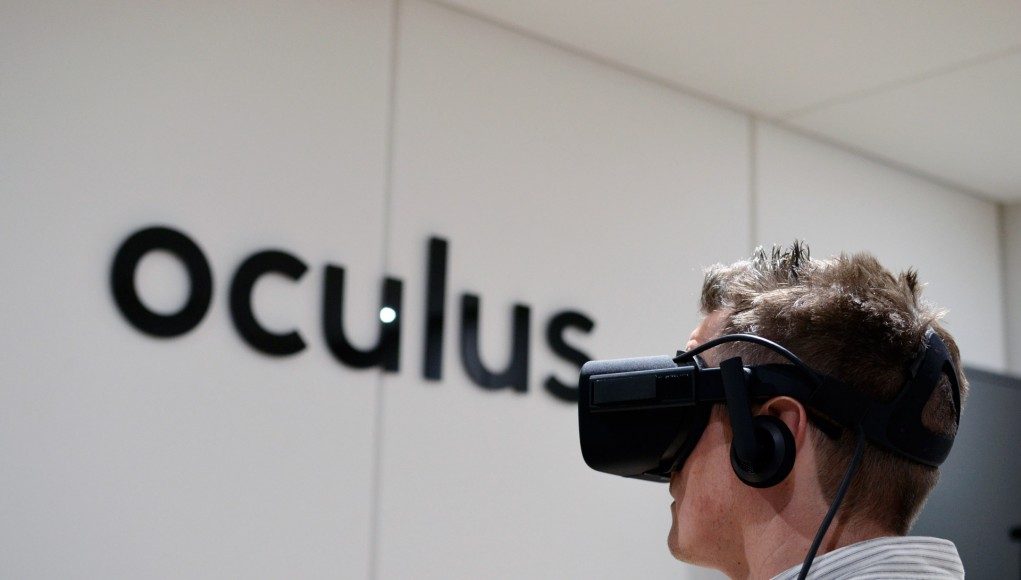As the biggest consumer electronics show looms large on the horizon, we look back on the most notable Oculus related VR events of 2015, what to look forward to in 2016 and what we’re likely to see from the company at CES.
This year, a statement I’ve heard more and more whilst roaming the wilds of the Interweb is something along the lines of “Is the Oculus Rift STILL not out yet?!”. These comments are simultaneously heartening and maddening, and here’s why: People asking this question, filled with disbelief that a product technically and commercially unthinkable just 4 years ago, isn’t already jostling for position on Best Buy shelves, are not generally VR enthusiasts. Even so, the expectation that a product which appeared as a Development Kit Kickstarter campaign just 3 years ago, would move from prototype to completed, consumer product in that time is clearly ludicrous.
![The Oculus Rift DK1 [Left] and DK2 [Right]](https://roadtovrlive-5ea0.kxcdn.com/wp-content/uploads/2014/04/oculus-rift-dk1-and-dk2-700x399.jpg)
At the same time however, the fact that people are becoming impatient, and in such numbers, is a testament to the visibility of VR outside of the enthusiast community heading into 2016. As more and more people have had opportunities to try virtual reality, word has spread that this is something special and people desperately want in. This is a great problem to have as Oculus prepares to launch their first assault on the VR market in the next few months.
Oculus in 2015
CES 2015 was all about the Crescent Bay feature prototype and positional audio for Oculus. The new headset, with integrated headphones (and it turns out an impressive audio pipeline) was on show to the public for the first time, having been unveiled to developers in September 2014 at Oculus’ inaugural Connect conference.
The company that Kickstarted (literally and figuratively) the virtual reality industry into renaissance, Oculus have continued a breakneck cycle of development and hardware iteration, finally culminating this year in the unveiling of what consumer can expect the final Oculus Rift (first generation) will look like.
We’d learned in May (somewhat prematurely thanks to a certain journalist) that Oculus were aiming for Q1 2016 to ship the Rift and along with it, we were treated
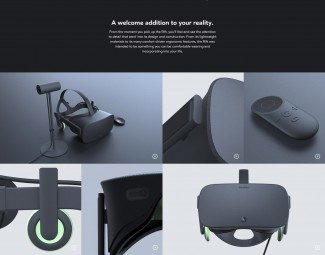
Just prior to the CV1’s unveiling, a web design snafu left renders of earlier prototype hardware discover-able to the public web, leaving inquisitive minds to pull down images which seemed to give us an early peek at what to expect. The images turned out to match the final design quite closely, with the headset and camera form-factors differing mainly in colour only. One other device appearing in these early images however, was a device still yet to make a public appearance – the Oculus Remote. Seemingly designed as a super-simplistic input device, this device seems to have been usurped by Oculus’ Touch motion controller.
 In a special press event held just before this year’s E3 expo, Oculus finally unveiled the final physical form for the Oculus Rift CV1. Sculpted by the industrial design team behind the legendary Xbox 360 controller, Carbon Design (now a part of Oculus), the consumer Rift is a handsome looking product – all things considered.
In a special press event held just before this year’s E3 expo, Oculus finally unveiled the final physical form for the Oculus Rift CV1. Sculpted by the industrial design team behind the legendary Xbox 360 controller, Carbon Design (now a part of Oculus), the consumer Rift is a handsome looking product – all things considered.
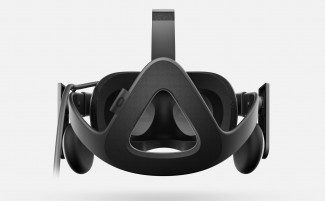
Tasked with taking an ungainly and unwieldy ‘box on your face’ device and making the Rift appealing, Carbon’s final design strips away weight, dropping the hard IR transparent shell seen in the company’s 2nd development kit (DK2), now replaced with lightweight, pleasantly tactile fabric. Sleek lines aimed at ‘slimming’ the form factor were now in evidence too. Ultimately, it was an obvious evolution of the then state of the art Crescent Bay prototype, right down to the integrated, clip-off headphones. The head harness is now rigid and spring-loaded, and the DK2’s retractable display assembly was now no where to be seen. In its place, an IPD adjustment slider on the underside of the headset.
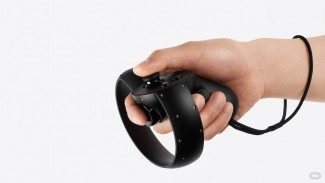
Perhaps more importantly however, was the first unveiling of Oculus’ solution to virtual reality input. The Oculus Touch is a dual-wielded, optically tracked input solution of beauty. Touch represents an elegant solution to a vexing problem: how to reach into and manipulate virtual worlds.
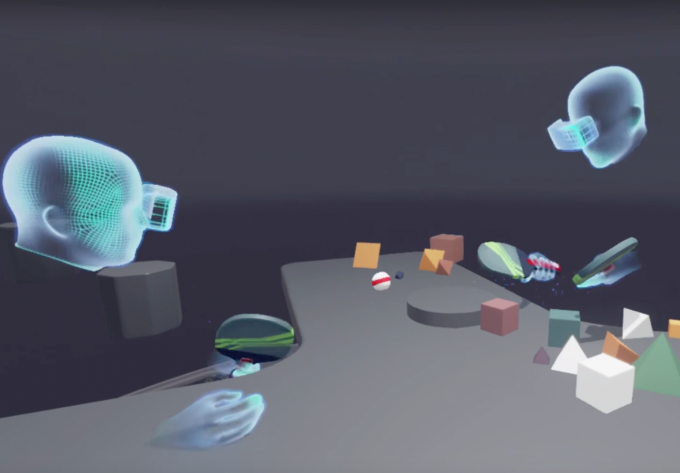
With IR LEDs adorning it’s hand-encompassing ‘Half Moon’ rings, the new controllers can detect finger gestures while providing full 6DOF movement for both hands. Ben Lang went hands-on with Oculus Touch at E3, giving us our first glimpse at Oculus’ virtual playground application, designed to showcase the Touch’s attributes, ‘Toybox’. The Touch however, won’t go on sale until the 2nd Half of 2016 – a few months after the Rift’s Q1 arrival – a fact that disappointed a vocal sector of the VR community.
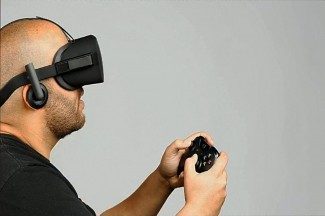
To that end, the news that Oculus had partnered with Microsoft to include a wireless Xbox One pad was treated with undeserved derision by some. The sound logic of Oculus’ argument, that all titles in development for the Rift have been built targeting an Xbox gamepad, seemingly falling on deaf ears in some quarters. It remains a smart move in my opinion and one that’ll see Oculus’ retail package nicely rounded out once it ships to consumers, whilst also providing a level of familiarity to ‘ease in’ new converts to virtual reality.

Elsewhere, Oculus doubled down on content in 2015. They launched Oculus Story Studios, staffed by ex Pixar talent and the studio’s first effort, Henry, was revealed to be bundled for free alongside the consumer Oculus Rift. They also pulled off a major coup, announcing a partnership with Microsoft to bring Minecraft to Oculus hardware in 2016.

Oculus Studios, the newly launched division tasked with driving VR content to the Rift platform, revealed its first Oculus Touch shooter Dead and Buried at Connect 2, which impressed. And, during the Game Awards 2015, Oculus announced it will be bringing Rockband VR to its platform in 2016. 3rd party software is on its way too, and at E3 Oculus demonstrated a new collection of made-for-VR titles on their way to the Rift. And the ever present Epic Games was on hand at Connect 2 to show off their Unreal Engine powered Oculus Touch shooter, Bullet Train.
With HTC’s recent announcement that their Valve-powered Vive headset will not now ship in 2015, Oculus now look to be on track to be the first to market with desktop VR hardware, claiming their Q1 2016 estimates look solid and with pre-orders expected early this month.
This is all without mention of Oculus’ push into mobile VR with Gear VR. We’ll look at this aspect in an upcoming Samsung retrospective.
Oculus at CES 2016
So, with an eventful 2015 behind them, what can we expect from Oculus at CES 2016?
Oculus founder Palmer Luckey has been unusually active and candid via social media in the last few weeks. Reading between the tweets, it seems that Oculus’ confidence is now high that the consumer version of their Rift VR headset will indeed ship in Q1 of 2016 as planned. Not only that, but pre-orders for the Rift may go live early very soon indeed.
@PalmerLuckey Preorders are coming soon after new year. Enjoy a stress-free holiday, we won't launch preorders without warning!
— Palmer Luckey (@PalmerLuckey) December 22, 2015
With CES looming in just a few days, that leaves the question as to whether Oculus will use the biggest consumer electronics show in the world as a launchpad for pre-orders or not. It would seem like a smart move, and one that would highlight to the world that the company is now ahead of the pack, being the first desktop consumer VR product to ship.
With pre-orders, by definition, comes pricing. Will we finally learn how much 1st generation consumer VR will set us back during CES? Oculus have been working hard to re-emphasise that the Rift is a hardware platform in and of itself, focusing hard on building a console-esque level of perceived value. We now know Rift early adopters will receive not only the VR headset, tracking camera and Xbox One wireless controller in the box. But with EVE:Valkyrie and Lucky’s Tale also shipping free with the headset, Oculus are woking hard to ensure consumers have everything they need to enjoy VR on day one, right out of the box.
We’ve also got the distinct impression this strategy is to soften the blow of the relatlively high cost of the unit. Oculus have repeatedly stated that they will aim to sell the Rift as cheaply as possible, but another recent tweet from Luckey emphasised just how costly this cutting-edge hardware is to produce.
Rift will be sold insanely cheap considering complexity – multiple high end OLED monitors+motion tracking+fancy mechanicals in one device.
— Palmer Luckey (@PalmerLuckey) December 24, 2015
CES as an event is traditionally hardware focused, so it’s possible we may get to see the latest iteration of the (now delayed) Oculus Touch motion controllers at the show. Oculus recently announced that the Touch consumer release will now slip to the second half of 2016 (from Q2) to give the firm time to perfect the units. If the devices are demo’d at CES, it’s not expected we’ll see any major functional changes from their last outing at Connect 2 in September with cosmetic and ergonomic tweaks seemingly indicated in recent image.
Fingers crossed for new VR content announcements at CES too. Whilst CES is largely hardware focussed, large gaming events are few and far prior to Oculus’ scheduled launch, with GDC 2016 not until March. As Palmer Luckey recently stated via Twitter:
Hardware with no games = paperweight. Oculus Studios is making tons of content, but third-party content will drive the long term VR market.
— Palmer Luckey (@PalmerLuckey) December 29, 2015
In Summary
Despite Valve and HTC’s stratospheric rise this year, Oculus remain the company to beat in 2016 in the desktop PC VR sector. They’ll be first to market with a product, bolstered by solid VR content and controller straight out of the box and the prospect of an excellent VR input solution later in 2016. Year one of consumer VR is upon us and the OG’s of virtual reality are now leading the pack.

